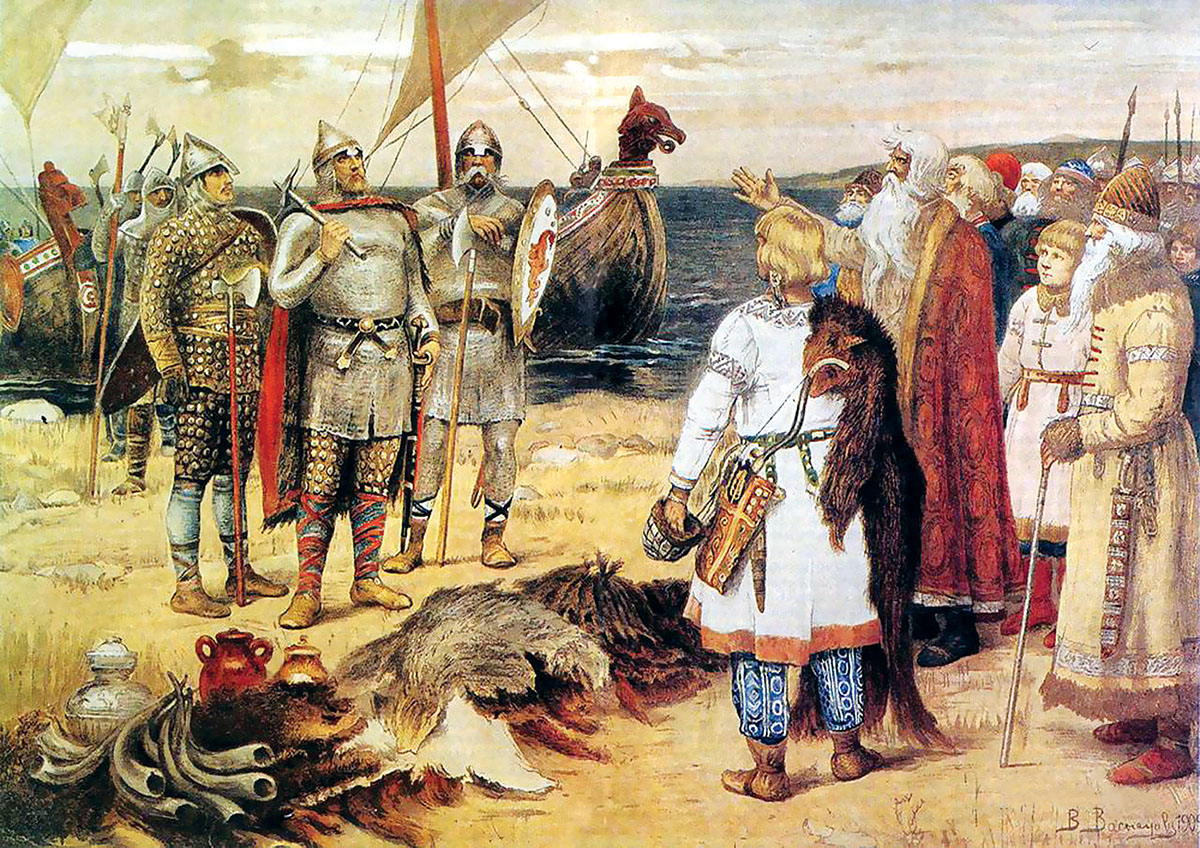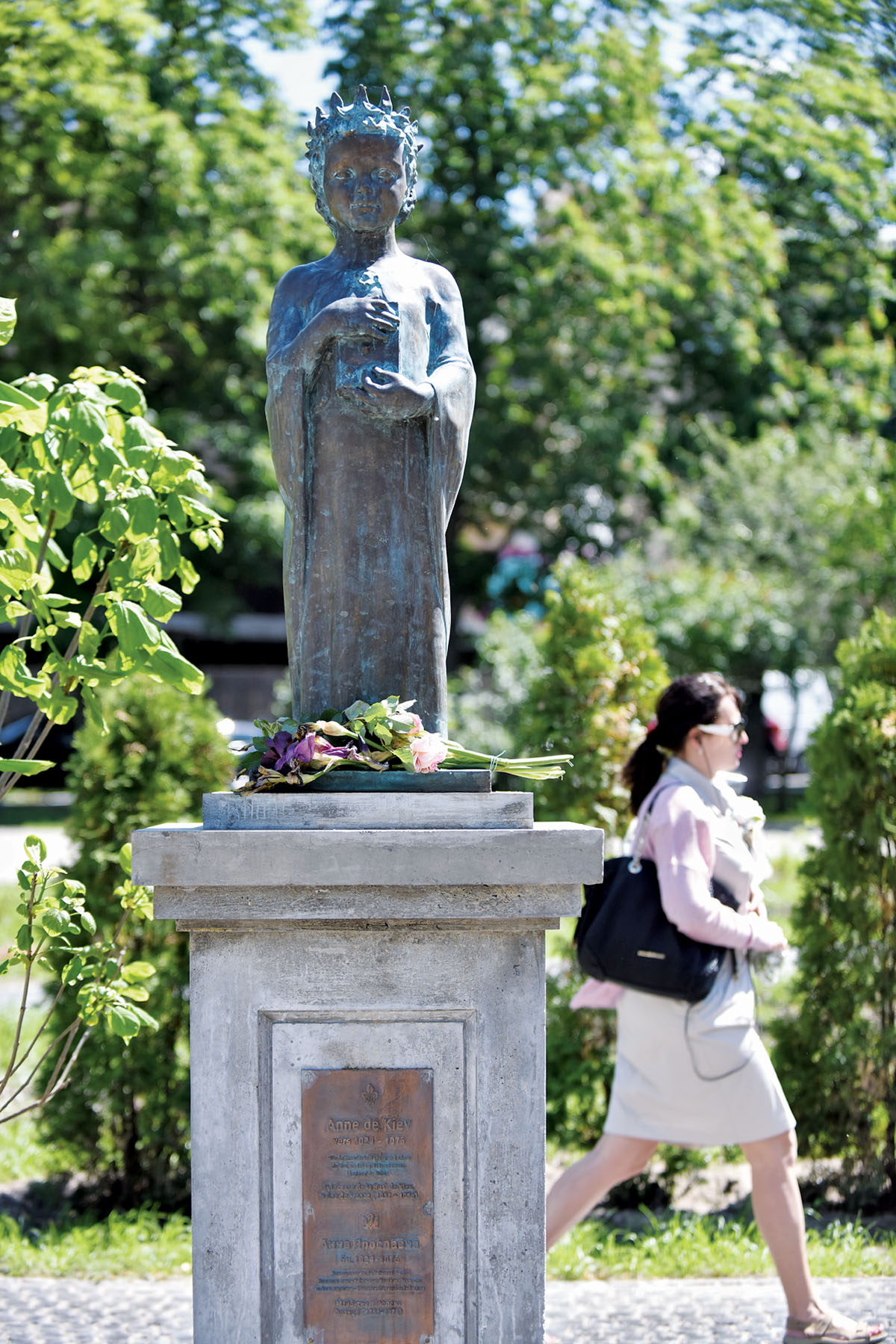Editor’s Note: The Kyiv Post starts “Honest History,” with this first in a series of stories and videos that aim to debunk myths about Ukrainian history that are used by propagandists. The series is supported by the Black Sea Trust, a project of the German Marshall Fund of the United States. Opinions expressed do not necessarily represent those of the Black Sea Trust, the German Marshall Fund or its partners.
Part 2 of the series was published on April 6, 2018: Honest History: Where, why Ukrainians speak Russian language (and how Kremlin uses it to stoke conflict in Ukraine)
Kyiv Post news editor Euan MacDonald explains how Russia falsifies the history of Kyivan Rus to Undermine Ukraine in the first episode of the Kyiv Post’s Honest History project.
When Russian President Vladimir Putin visited Versailles and held a joint press conference with French President Emmanuel Macron on May 29, he was anxious to stress the deep historical ties between the two nations.
Putin had come to France for the launch of an exhibition celebrating the 300th anniversary of the visit of Russian Czar Peter the Great to France, and was also there to sound out the newly elected Macron.
But if the wily and experienced Putin had hoped that he might awe the young French president, he was disappointed. It was the Russian leader who looked awkward and uncomfortable when Macron, standing at his side at the press conference after their talks, said the Kremlin propaganda media RT and Sputnik had spread false information during the 2017 French presidential election.
Claiming Anna
However, a comment made by Putin earlier in the press conference ruffled other diplomatic feathers. To illustrate deep ties between Russia and France, Putin alluded to a figure from even further back in history than Peter the Great.
“The enlightened French public knows of Russian Anna, Queen of France. The youngest daughter of our great king, Yaroslav the Wise, was the wife of Henri I (of France)…” Putin said in Russian.
Putin was referring to Anna of Kyiv, who had indeed wed Henri I of France in 1051 to become Queen of France, and who was a daughter of one of the greatest princes of the Kyivan Rus, Yaroslav the Wise.
But by using the adjective “Russian” to describe Anna, and describing Yaroslav the Wise as “our great prince,” Putin was claiming Anna was Russian, and that the Kyivan Rus King Yaroslav the Wise was a Russian prince.
Ukraine quickly responded, though not with a diplomatic note, but a tweet from its official Twitter account. The tweet included a picture with a brief biography of Anna of Kyiv and a picture of birch woodland under the text “1051: Meanwhile, in Moscow…” The implication was Russia could not claim Anna of Kyiv as Russian because Russia did not exist in her time.
Kidnapping Volodymyr
This wasn’t the first time Russia had laid claim to Kyivan Rus royalty. Putin on Nov. 4, 2016 unveiled in front of the Kremlin a giant statue of the Kyivan Rus Prince Volodymyr the Great (Vladimir, in Russian transliteration), the father of Yaroslav the Wise. Volodymyr, an Orthodox Christian saint, introduced Christianity to Kyivan Rus in 988.
The figure of Moscow’s Volodymyr is 12.2 meters high, and the total height of the monument from the base of the plinth to the top of the cross carried by the prince is 17 meters. In contrast, the figure on the monument to Volodymyr the Great in Kyiv is a mere 4.4 meters high, although the entire monument including the 16-meter plinth is higher, at 20.2 meters.
But the monument was controversial not just because of its size: There are no direct links between Moscow and the prince at all, given that Moscow did not yet exist when he was alive. Rather, erecting a huge statue of the Kyivan Rus prince in the heart of Moscow, overlooking the Kremlin, was a political statement, according to Alexei Venediktov, editor-in-chief of radio station Ekho Moskvy.

Rurik and his brothers Sineus and Truvor arrive at Ladoga. Painting by Russian artist Apollinary Vasnetsov (1856-1933). Rurik, a Viking, was the founder of the dynasty that ruled Kyivan Rus. (Apollinary Vasnetsov)
“It’s obvious that this isn’t an aesthetic or cultural decision, but a political one,” Venediktov wrote, as reported in an article in the United Kingdom newspaper the Guardian (“Why a giant statue of Vladimir is causing a public outcry in Moscow,” by Shaun Walker, June 11, 2015).
“It’s a message to the Ukrainian capital to say: ‘St. Vladimir is ours, not yours,’” Venediktov wrote.
The message is consistent with the propaganda narrative that the Kremlin has maintained since it annexed Crimea and launched its war on Ukraine in the Donbas in 2014 — the people of Ukraine and Russia are “one people” (a phrase Putin has used many times) and thus Ukraine is not really an independent, sovereign state, but an unruly lost province temporarily out of Moscow’s direct control.
The Kremlin has used this propaganda message along with others to justify its occupation of Ukraine’s Crimean peninsula and its support for its proxy forces battling the Ukrainian army in the Donbas.
Whose history?
But what are the facts? Who has the greater claim to Anna, Yaroslav the Wise and Volodymyr the Great — Ukraine or Russia? And can Ukrainians and Russians really be considered to be the same people? The short answer is — no.
At its height in the mid‑11th century, Kyivan Rus was the largest state in Europe and, because of its control of key trade routes, one of the richest. According to the Russian Primary Chronicle, the state was founded in 882, when Prince Oleg, the brother-in-law of Rurik, founder of the Rus royal dynasty, conquered Kyiv, made it his capital, and proclaimed it the “mother city of the Rus.”
Kyiv was at that time inhabited by Slavs who paid tribute to the Khazars, a confederation of mainly Turkic tribes who dominated the steppe land in what is now eastern Ukraine, eastern and southern Russia, the Caucuses, and parts of Central Asia as far as the Aral Sea in the east.
Under Oleg, the various Rus states united into a single political unit stretching from the Baltic Sea, Lake Ladoga and Lake Onega in the north, to the tip of Crimea (though not the whole of the peninsula) in the south. What is now southern and eastern Ukraine, though partly settled by Slavs, was mostly not part of Kyivan Rus, but was under the shifting and changing control of various tribes and invaders from the east.
After the reign of Yaroslav the Wise, from 1054, Kyiv Rus underwent gradual disintegration due to feuding between the rulers of its various constituent principalities over the succession to the title of Grand Prince of Kyiv.
Kyivan Rus was finally doomed by the invasion of the Mongols from the east in 1237–1240. The state broke apart into separate Rus principalities that paid tribute to the invaders for centuries to come.
Successor states
After a long period of domination by the Mongols and their Turkic successors the Golden Horde, control of the area that had been Kyivan Rus was by the beginning of the 16th century split between two large states. The Grand Duchy of Lithuania controlled most of what is now Ukraine and Belarus (apart from southeastern Ukraine and Crimea, which was under the Crimean Khanate), while the Grand Duchy of Muscovy occupied what is now the northeastern part of modern European Russia.
However, the grand dukes of Muscovy laid claim to all of the lands of the former Kyivan Rus, seeing themselves as direct successors to that ancient state. Under the successor state to Muscovy — the Tsardom of Russia — the area under Moscow’s control grew immensely, stretching through Siberia to the Far East. However, it still did not directly control most of the land that would one day be today’s Ukraine, or the “mother city of Russia” — Kyiv. That was still under Polish-Lithuanian control.
An uprising against Polish control in the east of Ukraine under Ukrainian Hetman Bogdan Khmelnytsky in the mid‑17th century led the lands east of the Dnipro River and the city of Kyiv to become autonomous under the Cossack Zaporizhian Sich, at the price of Khmelnytsky’s oath of allegiance to the Russian Tsar. The south of Ukraine, from its modern western to eastern borders, remained under the control of the Ottoman Empire. After the Polish-Lithuanian Commonwealth lost a war against the Tsardom of Russia in 1667, the rest of eastern Ukraine, including Kyiv, was ceded to Russia by Poland.

A woman walks past a memorial to Anna of Kyiv in on June 1, 2017. At a press conference in France a few days earlier, Russian President Vladimir Putin referred to the Kyivan Rus princess as “Russian Anna,” prompting an online diplomatic spat with Ukraine. (Oleg Petrasiuk)
After the Russian Empire was proclaimed in 1721 under Peter the Great, Moscow continued to expand its control westward and southward, defeating the Polish-Lithuanian Commonwealth, and by the end of the 19th century gaining control over most of what is now modern-day Ukraine. Following a brief struggle for independence when the Russian Empire ended in 1917, Ukraine (apart from its far western regions) was effectively absorbed by Russia in 1922 under the Soviet Union, as the Ukrainian Soviet Socialist Republic.
Modern Ukraine assumed its present shape after the Soviet annexation of western Ukraine in 1939 and the granting of Crimea to Ukraine in 1954 by Soviet leader Nikita Khrushchev. These were the borders assumed by Ukraine when it gained independence following the collapse of the Soviet Union in 1991.
Who were the Rus?
It is clear that the Russian state that emerged from the ashes of the Soviet Union, the Russian Federation, is a direct political successor of the Grand Duchy of Muscovy. But due to the destruction and fragmentation of Kyiv Rus by the Mongol invasion, modern Russia cannot be said to be the direct successor of Kyivan Rus, and its claims to be the direct inheritor of Kyivan Rus lands and history are spurious.
However, the same could be said for the modern Ukrainian state, which presently covers an area that has been occupied by numerous, tribes, peoples, nations, states and empires over the millennia, of whom the Kyivan Rus were by no means the first.
There is another twist to the tale: Oleg, the founder of Kyivan Rus, was the son of Rurik, who is generally thought to have been a Varangian — what we nowadays call a Viking.
The Rus, from which the countries Belarus and Russia derive their names, appear to have been a Scandinavian people who adopted Slavic culture and language after taking political control of the area. While this is disputed by Russian scholars, a similar case can be seen in western Europe, where Vikings settled in northern France and adopted French language and culture while lording it over the locals; they were the Normans, or Norsemen — Vikings. One of their leaders, William the Conqueror, invaded England in 1066 to bring a French-speaking nobility to power there.
So Putin’s propaganda narrative obscures the complex and uncertain history of the region, which intertwines Slavic, Scandinavian, Khazar, Turkic, and Mongol ruling families, states and empires, as well as shifting Ottoman, Lithuanian, Polish, Swedish and Russian imperial influences on the lands that centuries before were home to Yaroslav the Wise and his daughter Anna.
Putin’s claim that they or Volodymyr the Great are intrinsically Russian makes no more sense than to claim that the Norman kings of England are intrinsically British — it is a politically expedient claim, not a historically accurate one, of the type frequently used by past kings, emperors and dictators to justify claims to lands that are not their own.
